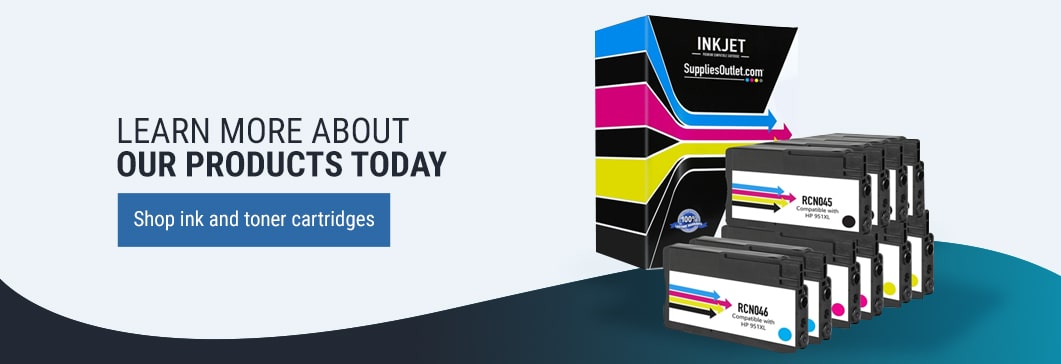Printers are an essential part of office supplies. When choosing one for your home or business, you have the choice between two main types of printers — laser and traditional. The one you choose will depend on what you print, how frequently you print and many other factors. In this article, we'll help you decide which type is best for your application.
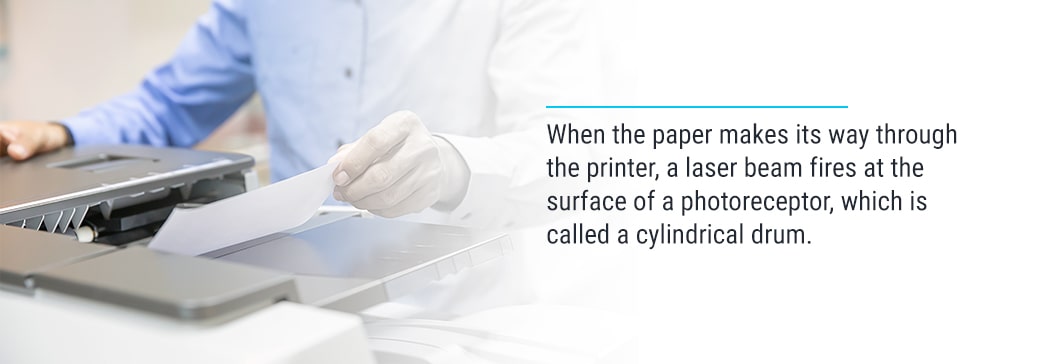
What Are Laser Printers?
Laser printers transfer images and text on paper by using a focused beam of light. Although it is commonly believed that the lasers "burn" the images onto the paper, the process is quite different. When the paper makes its way through the printer, a laser beam fires at the surface of a photoreceptor, which is called a cylindrical drum. The photoreceptor carries an electrical charge, which is usually positive and becomes reversed in places hit by the laser beam. When the charge in certain parts of the drum is reversed, the laser beam can print pictures, text and other patterns onto the photoreceptor.
Once the laser has created a pattern on the drum, it is then coated with toner from a toner cartridge. While the color of the toner is generally black, cartridges are also available in cyan, yellow and magenta. The toner, which is positively charged, sticks to parts of the drum that the laser has negatively charged. When the paper goes through the printer, the drum is given a strong negative charge, transferring the toner and sticking to the paper. This results in a clean copy of the image written on the paper.
Since laser printers don't use ink, they don't have as many smearing issues as their inkjet counterparts and can print pages more quickly. Even though most laser printers and toner cartridges are more costly than inkjet printers and ink cartridges, laser toner cartridges also last longer than ink cartridges because of their capacity, so the cost per page comes out to be more or less the same.
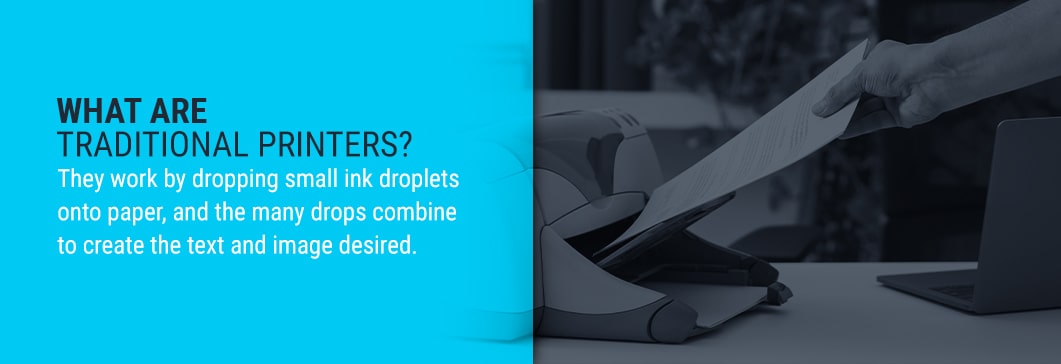
What Are Traditional Printers?
Traditional, or inkjet, printers are the type found in practically all homes and office spaces and are commonly used to print photos, invoices, homework, newsletters and color business documents. They work by dropping small ink droplets onto paper, and the many drops combine to create the text and image desired. The sizes and color of the droplets can be changed to make sharp, photo-realistic images. The copy resolution of the printer can be gauged by the dots per inch, which indicates the number of tiny droplets that can fit along one inch of a page. A higher DPI means the dots are smaller and, as a result, the image is sharper.
The primary difference between inkjet and laser printing is that inkjets use ink cartridges while a laser printer uses laser toner. Here are some of the other primary components of an inkjet printer:
- Print head: A very important part of an inkjet printer, the print head features nozzles that spray ink drops on the paper.
- Ink cartridge: An inkjet printer can have a variety of ink cartridge combinations depending on the model.
- Stepper motor: This motor moves the print head and cartridge back and forth over the paper.
- Belt: This belt connects the stepper motor to the print head.
The print head is the most essential part of the inkjet printer, as it is the component that sprays ink onto the paper. It contains many closely arranged nozzles to make sure the ink is sprayed onto various surfaces, including paper, canvas, and fabric. The way that ink is sprayed onto paper depends on the underlying technology, of which there are three different types:
- Piezoelectric: Piezoelectric ink cartridges transmit a tiny electric charge to the piezo crystal behind the ink reservoir, thereby controlling ink flow. They vibrate the crystals, causing a droplet of ink to be forced out and sprayed through the nozzle. When the crystals vibrate outward, more ink is drawn in from the reservoir to replace the ink that has been sprayed.
- Thermal bubble: This method of ink spraying utilizes heat that is contained within the ink cartridge. The resistors in the cartridge generate heat, which vaporizes the ink into a bubble. The bubble expands, which causes the ink to be pushed out of the nozzle. When the bubble pops, it creates a vacuum, pulling more ink to the head of the cartridge. Using thermal bubble technology, the print heads on inkjet printers contain hundreds of little nozzles that can fire a droplet. The ink used for thermal bubble technology is usually dye-based, water-based and pigment-based.
- Continuous inkjet: This inkjet technology is mainly used for the marking and coding of packages and products. With this technology, a high-pressure pump directs ink from the reservoir with a nozzle, which creates an ink stream. The droplets form by a charging electrode and are subjected to an electrostatic field. They are subsequently deflected to the receptor material, where they are printed with electrostatic deflection plates.
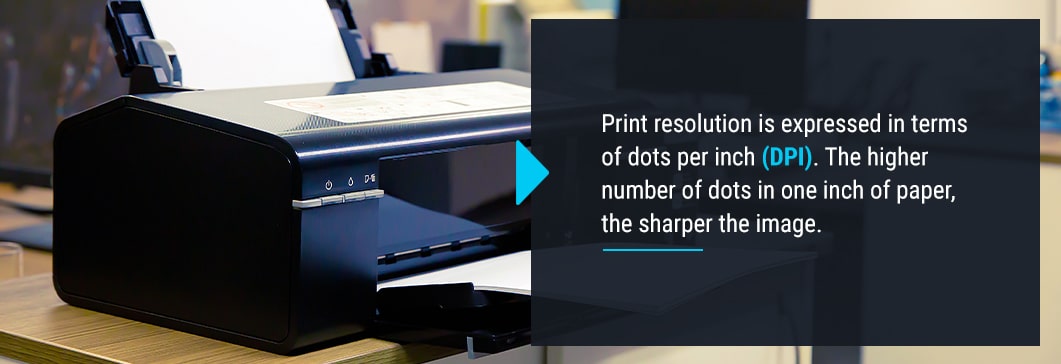
Comparing Print Resolution
Print resolution is expressed in terms of dots per inch (DPI). The higher number of dots in one inch of paper, the sharper the image. To print high-resolution documents, your printer should have a resolution of 600 DPI, and to print high-quality colored images, the printer should have 1200 DPI resolution. Although a high DPI means a sharper image, once you get above 1200 DPI, it is difficult to tell the difference.
When looking at a printer's specifications, the print resolution is expressed as two numbers, such as 4800 x 1200 DPI, meaning that the maximum resolution is 4800 times 1200 DPI. Inkjet printers today tend to have a 5,000-DPI maximum resolution, whereas most laser printers have resolutions as high as 2,400 x 600 DPI. However, newer laser printers can optimize their DPI to provide print resolutions of 38,400 x 600 DPI.
To provide a summary of the best applications for each type of printer:
- Monochrome laser printers are great for documents and text.
- Color laser printers are perfect for documents, text and printing medium-quality color images, such as personal-use family photos.
- Photo inkjet printers are excellent for high-quality photos that have great tonal depth and a wide color range. They're best for printing photo gallery print.
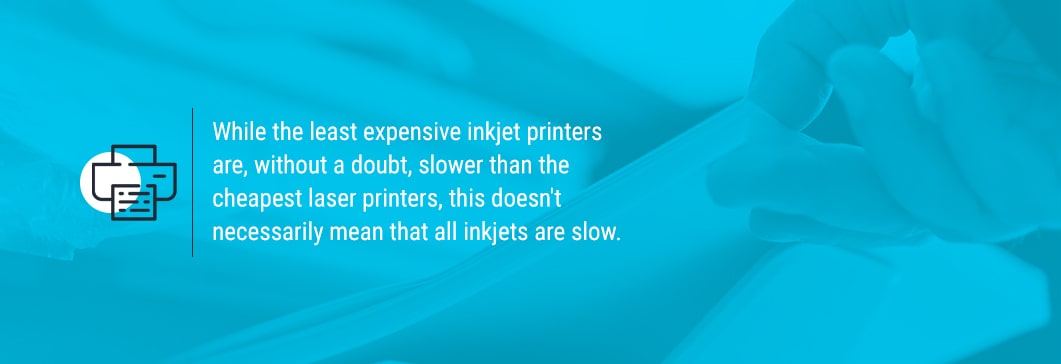
Comparing Printing Speed
While the least expensive inkjet printers are, without a doubt, slower than the cheapest laser printers, this doesn't necessarily mean that all inkjets are slow. Because laser technology maps and applies toner to a complete page simultaneously, it's inherently quicker than how the majority of inkjet printers put ink on paper. This is typically done by sending a print head with various nozzles back and forth over a page, spraying one line of ink after another. Some cheap inkjets are only able to print around eight pages a minute, whereas some of the most inexpensive, low-end laser printers can print at two times that rate. When you move into higher-end models of both inkjets and laser printers, their speeds are comparable, with the majority of both printing between 20 and 25 pages per minute.
Generally speaking, laser printers can print faster than inkjets. However, if an inkjet is properly configured, it isn't necessarily slower, and certain models can outpace lasers easily. What's more, if you only use your printer to print a page or two every now and then for your home office or school, practically any printer will be fast enough to meet your needs.
Comparing Costs
When it comes time to shop for a printer, the cost is a major factor for most buyers. In this section, we'll discuss what prices you can expect for inkjet and laser models on the market today.
Generally speaking, inkjet printers are considerably less pricy than their laser counterparts. This is mainly due to the technology being a bit less complex and, as a result, less expensive to make. Most inkjet manufacturers sell their products at a loss, knowing this difference can be made up with ink cartridge sales later on. In some cases, buying a new printer is cheaper than buying a new set of ink cartridges!
On the other hand, laser printers rarely sell for less than $200, with the most affordable models selling for no less than $150. While you should definitely consider the cost of printing when making a decision, if you hardly print — or are planning to use your printer's scan and fax functions more than actual printing — you should be fine with getting a more affordable option for as low as $50.
In summary, inkjet printers are less costly, but you may end up paying more in the long run.
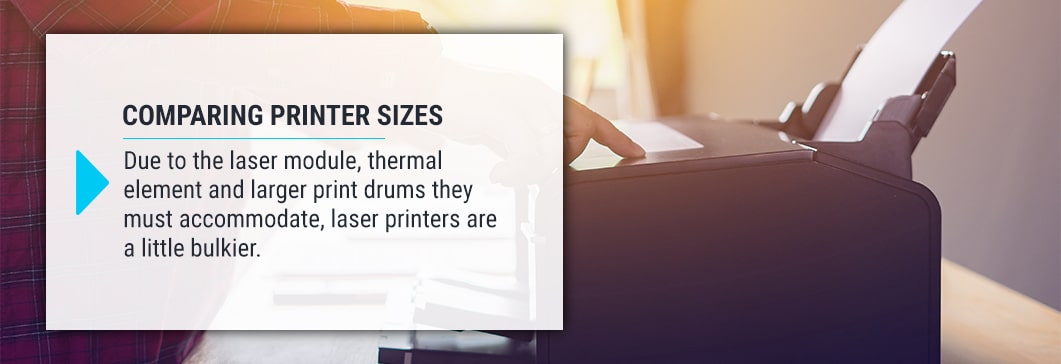
Comparing Printer Sizes
Another important factor that printer shoppers may forget to consider is printer size. While printers obviously vary in design and size, laser printers tend to be heavier and bigger than inkjet printers. If the space on your shelf or desk is limited, an inkjet printer is more likely to fit. Inkjet printers have become smaller over the years, thanks to new features such as print heads that are built into the ink cartridges. Some inkjets are so small that they are portable, weighing less than ten pounds.
Due to the laser module, thermal element and larger print drums they must accommodate, laser printers are a little bulkier. This is especially true if they include multifunction features such as copying and scanning. If you are tight on space, an inkjet printer might be the better choice.
Pros and Cons of Traditional Printers
Thanks to affordable startup costs and wide availability, the majority of households today use inkjets for everyday printing. However, laser printers — even color models — are becoming more and more affordable and available in suitable sizes for homes and small offices. If you have an inkjet printer and are wondering whether you should make the jump to a laser model, you'll have to consider your printer usage.
Some of the biggest pros of inkjet printers are:
- They're excellent for photos: They are also great for documents that are image-heavy. Inkjet printers are better at blending smooth colors than their laser counterparts.
- Their startup cost is low: Inkjet printers do not cost as much as laser printers. Inkjet ink cartridges are also less costly than toner cartridges.
- They can print onto many kinds of paper: These include textured stationery, glossy photo paper and even certain fabrics.
- They don't require much warm-up time: If you need to start printing quickly, inkjet printers are a great choice.
- They produce less waste: You can refill and reuse inkjet cartridges, which reduces waste and saves money.
- Convenience size and low maintenance: Inkjets are usually lighter, smaller and require less maintenance than laser printers.
Inkjet printers also come with a number of disadvantages, which may make them a less-than-ideal choice for your situation. These include:
- The ink is expensive: In fact, it is often through the ink cartridges that many inkjet printing manufacturers make most of their money.
- Inkjet prints are susceptible to fading and water damage: This is due to the fact that inkjet ink is water-based.
- Ink cartridges require regular cleaning: While printers automatically perform this maintenance, much ink is wasted in the process.
- They're still relatively slow: Although inkjets are printing at faster speeds than they used to, when compared to laser printers, they're still quite slow. If you want to print at high volumes, inkjet printers often make this challenging.
- The quality is often lacking when printing on plain office paper: Inkjet printers will often produce fuzzy, gray text on plain office paper.
- The paper capacity is generally lower: Inkjet printers designed for home use often have low-capacity paper trays that only hold between 50 and 100 sheets. Output trays are also almost always nonexistent. If you plan to do lots of printing, this could be a reason to opt for a laser printer instead.
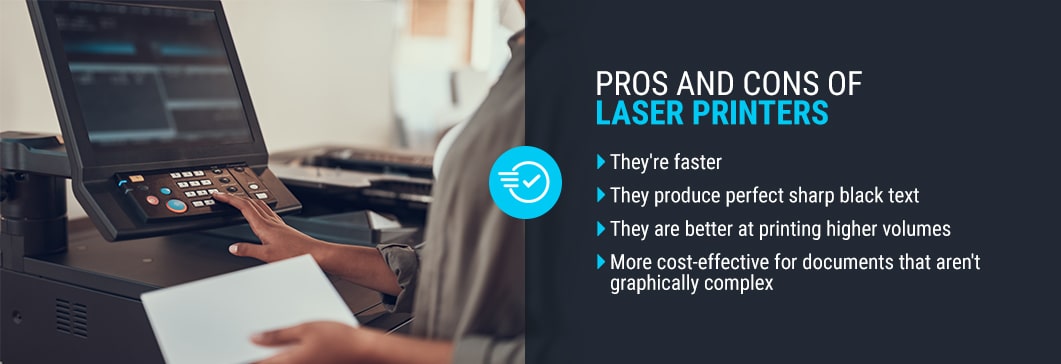
Pros and Cons of Laser Printers
In this section, we'll cover some of the advantages and disadvantages associated with laser printers. Some of the most significant advantages include:
- They're faster: Despite the advancements in speed that inkjet printers have seen in recent years, laser printers are still the faster of the two types. If you only print a few pages at a time, it won't make much of a difference, but if you need to print high volumes regularly, you'll be able to do so much faster with a laser printer.
- They produce perfect sharp black text: If what you print is usually text with occasional graphics, you'll want to opt for a laser printer. Laser printers are also better at handling fine lines and small fonts.
- They are better at printing higher volumes: Laser printers are better prepared at handling high-volume print jobs.
- More cost-effective for documents that aren't graphically complex: Even though the toner cartridges for laser printers are more expensive than inkjet cartridges, toner cartridges print more sheets relative to their cost than inkjet cartridges do. They also produce less waste.
The major disadvantages of laser printers are as follows:
- They take more time to warm up: Although laser printers print faster, they generally take more time to warm up.
- Laser printers cost more: Even though toner is less expensive over time, the upfront costs of laser printers are higher.
- Leaking can be a nightmare: If your toner leaks, it is a major inconvenience.
- They are unable to print on many paper varieties: Whereas inkjets can handle a wide variety of paper types, laser printers cannot. You can't run anything heat-sensitive through laser printers, either.
- They're not the best for printing photos: A home laser printer can print simple graphics, but they struggle to print smooth photographs. If you need to print high-quality photos, inkjet is the type of printer you'll want.
- They're generally bulky: While there are some compact laser printers out there, generally speaking, laser printers are heavier and bigger than inkjets.
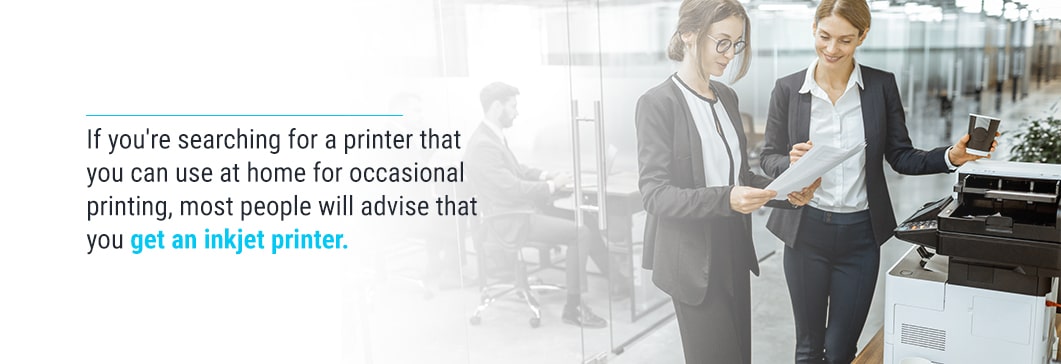
Considering What You Will Be Using the Printer For
If you're searching for a printer that you can use at home for occasional printing, most people will advise that you get an inkjet printer. However, one frequent complaint about inkjet printers is that their ink dries up if they are not used frequently. If this is an issue for you and your budget allows it, consider buying an affordable laser printer, as the toner doesn't usually dry up like the ink in inkjet printers. This is especially helpful to think about if you are someone who works from home.
If you plan to use your printer mainly to print a small volume of documents and need high-res colored images on a regular basis, an inkjet printer will be sufficient. Laser printers are better suited for printing large volumes of monochrome and color documents frequently.
You may want to consider an inkjet printer if any of the following situations apply to you:
- You require a printer for high-quality photos.
- You only print out small volumes.
- You have limited space for a printer.
- You print documents on a variety of different paper varieties.
On the other hand, you may want to consider a laser printer if any of the following are applicable:
- You must print large volumes.
- You have the space to accommodate a laser printer, which tends to be bulkier.
- You mainly print out documents with text and graphics that aren't complex.
- You prefer that your text is exceptionally sharp.

The Benefits of the Supplies Outlet
Supplies Outlet is an online retailer that sells compatible and remanufactured printer cartridges. We are committed to providing our customers with the highest value by offering thoroughly tested, high-quality products, competitive prices and superior customer service.
Our management team boasts over three decades of experience in the industries of computer supplies and accessories, and the companies they've founded have sold hundreds of millions of dollars worth of products. The products we sell are 100% compatible with the manufacturers' original brand products that they replace and they won't void your warranty. Additionally, our products are all covered by our one-year, hassle-free warranty as well as a 60-day money-back guarantee.
We are able to offer such affordable prices for these best-selling cartridges because we source them directly from quality-certified manufacturers around the world. We can maintain the highest quality levels consistently because our manufacturers make use of the best raw materials and strive to constantly improve their manufacturing methods.
Learn More About Our Products Today
When shopping at Supplies Outlet, you enjoy the high-quality products at competitive prices as well as unbeatable customer service. If you have any questions about our products or an order, don't hesitate to reach out to us using our form. One of our friendly team members will respond to you shortly.

 Log in
Log in



